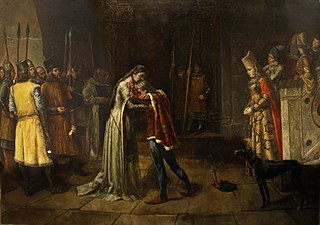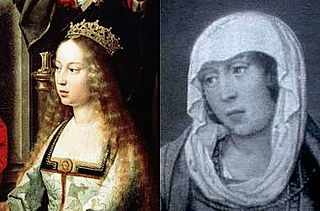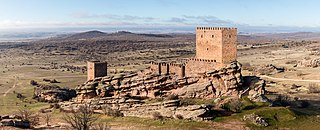
Ferdinand II, was a member of the Castilian cadet branch of the House of Ivrea and King of León and Galicia from 1157 until his death.

Ferdinand IV of Castile called the Summoned, was King of Castile and León from 1295 until his death.

Joanna of Castile, known as la Beltraneja, was a claimant to the throne of Castile, and Queen of Portugal as the wife of King Afonso V, her uncle.

Henry IV of Castile, nicknamed the Impotent, was King of Castile and León and the last of the weak late-medieval kings of Castile and León. During Henry's reign, the nobles became more powerful and the nation became less centralised.

Eleanor of Alburquerque was a Castilian noblewoman, Countess of Alburquerque, who became Queen of Aragon by her marriage to Ferdinand I of Aragon. She was the regent of Aragon during the absence of her son the king in 1420.

Leonor (Eleanor) de Guzmán y Ponce de León (1310–1351) was a Castilian noblewoman. After about 1330, she became the long-term mistress and favourite of Alfonso XI, with whom she had the illegitimate son Henry "the Fratricidal", future first monarch of the House of Trastámara. She held the lordship of Medina-Sidonia until she fell from grace in the wake of Alfonso's death in 1350. She was then executed by her enemies.

Medina del Campo is a town and municipality of Spain located in the autonomous community of Castile and León. Part of the Province of Valladolid, it is the centre of a farming area.

The Crown of Castile was a medieval polity in the Iberian Peninsula that formed in 1230 as a result of the third and definitive union of the crowns and, some decades later, the parliaments of the kingdoms of Castile and León upon the accession of the then Castilian king, Ferdinand III, to the vacant Leonese throne. It continued to exist as a separate entity after the personal union in 1469 of the crowns of Castile and Aragon with the marriage of the Catholic Monarchs up to the promulgation of the Nueva Planta decrees by Philip V in 1715.

The War of the Castilian Succession was the military conflict contested from 1475 to 1479 for the succession of the Crown of Castile fought between the supporters of Joanna 'la Beltraneja', reputed daughter of the late monarch Henry IV of Castile, and those of Henry's half-sister, Isabella, who was ultimately successful.

Isabella I, also called Isabella the Catholic, was Queen of Castile and León from 1474 until her death in 1504. She was also Queen of Aragon from 1479 until her death as the wife of King Ferdinand II. Reigning together over a dynastically unified Spain, Isabella and Ferdinand are known as the Catholic Monarchs.
Marquis of Gibraltar was a short-lived Castilian noble title (1478–1501). It belonged to the House of Medina Sidonia.

Diego López V de Haro, nicknamed el Intruso, was a Castilian noble of the House of Haro and held the title of the Lord of Biscay which he took from the pretender to the title, John of Castile.

The Castle of Alarcón forms part of the fortifications built around the town of Alarcón in Cuenca, Spain. The fortress is composed of a walled enclosure, which houses the heart of the population and the castle proper, and of five exterior towers, separate and strategically placed.

The Castle of Zafra is a 12th-century castle in the municipality of Campillo de Dueñas, in Guadalajara, Spain. Built in the late 12th or early 13th century on a sandstone outcrop in the Sierra de Caldereros, it stands on the site of a former Visigothic and Moorish fortification that fell into Christian hands in 1129. It had considerable strategic importance as a virtually impregnable defensive work on the border between Christian and Muslim-ruled territory.

The Castle of Burgos was a castle and alcázar, located in the city of Burgos, in the hill of San Miguel to 75 metres (246 ft) above the city and to 981 metres (3,219 ft) above the sea. This hill was the subject of archaeological surveys by General Centeno in the years 1925 and 1926 trying to find Napoleonic military files from when the French in their retreat blew up the fortress. According to the results obtained in this excavation the origin of the castle dates to the Visigoths, and its oldest parts, to the Romans.

The coat of arms of Castile was the heraldic emblem of its monarchs. Historian Michel Pastoureau says that the original purpose of heraldic emblems and seals was to facilitate the exercise of power and the identification of the ruler, due to what they offered for achieving these aims. These symbols were associated with the kingdom, and eventually also represented the intangible nature of the national sentiment or sense of belonging to a territory.

The Castilian House of Ivrea, also known as the House of Burgundy, is a cadet branch of the House of Ivrea descended from Raymond of Burgundy. Raymond married Urraca, the eldest legitimate daughter of Alfonso VI of León and Castile of the House of Jiménez. Two years after Raymond's death, Urraca succeeded her father and became queen of Castile and León; Urraca's and Raymond's offspring in the legitimate line ruled the kingdom from 1126 until the death of Peter of Castile in 1369, while their descendants in an illegitimate line, the House of Trastámara, would rule Castile and Aragón into the 16th century.

Álvaro de Zúñiga y Guzmán was a Castilian nobleman, member of the influential House of Zúñiga, of Navarrese origin. He was one of the most powerful men in Castile, as evidenced by his numerous titles and the offices he held, and was involved in much of the kingdom's most important political and military events, notably in the various conflicts between the nobility and the candidates for succession to the throne that would culminate in the War of the Castilian Succession and that would only calm down with the final recognition of the Catholic Monarchs, whom he initially opposed but eventually supported.

The Castilian Civil War of 1437–1445 was a civil war in which two noble factions fought for power in the Crown of Castile. On one side was Constable Álvaro de Luna, King John II of Castile, and Henry Prince of Asturias. On the other side was the noble League led by Infantes of Aragon John and Henry, sons of Ferdinand of Antequera, who was the regent of Castile during the minority of John II. Although the Infantes of Aragon faction won in 1441, imposing their conditions in the Medina del Campo ruling, the final victory went to the royalist faction and the Constable, who won the decisive battle of Olmedo. According to historian Carme Batlle, Álvaro de Luna is primarily responsible for the war. Following his victory over the Infantes of Aragon during the truces of Majano, Luna's "authoritarian excesses" escalated and led to a civil war. Although Batlle places the war's start in 1439.























